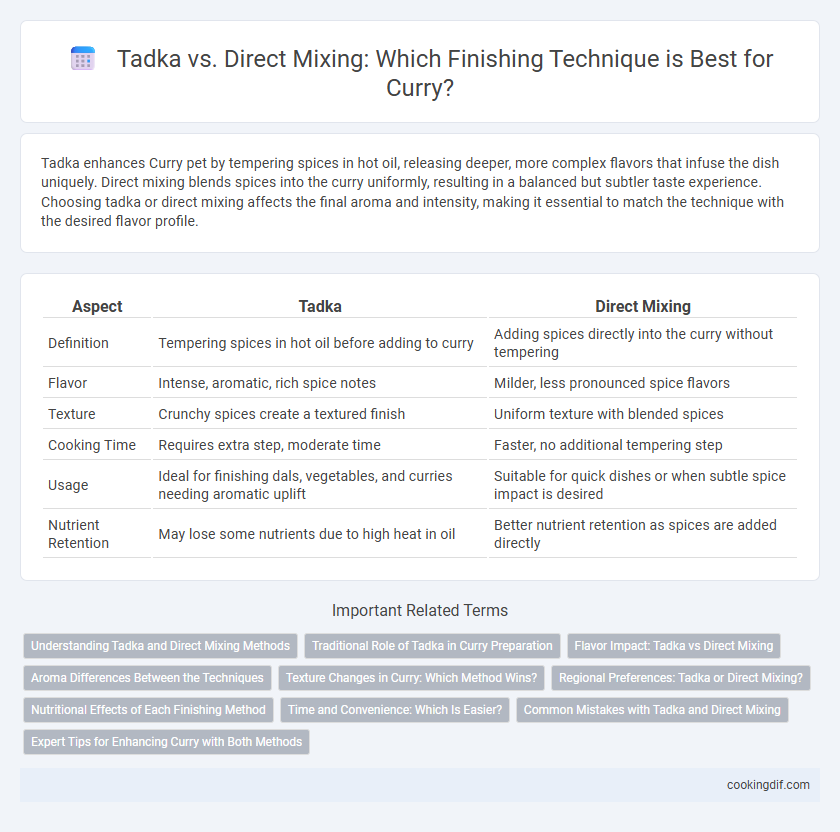Tadka enhances Curry pet by tempering spices in hot oil, releasing deeper, more complex flavors that infuse the dish uniquely. Direct mixing blends spices into the curry uniformly, resulting in a balanced but subtler taste experience. Choosing tadka or direct mixing affects the final aroma and intensity, making it essential to match the technique with the desired flavor profile.
Table of Comparison
| Aspect | Tadka | Direct Mixing |
|---|---|---|
| Definition | Tempering spices in hot oil before adding to curry | Adding spices directly into the curry without tempering |
| Flavor | Intense, aromatic, rich spice notes | Milder, less pronounced spice flavors |
| Texture | Crunchy spices create a textured finish | Uniform texture with blended spices |
| Cooking Time | Requires extra step, moderate time | Faster, no additional tempering step |
| Usage | Ideal for finishing dals, vegetables, and curries needing aromatic uplift | Suitable for quick dishes or when subtle spice impact is desired |
| Nutrient Retention | May lose some nutrients due to high heat in oil | Better nutrient retention as spices are added directly |
Understanding Tadka and Direct Mixing Methods
Tadka involves tempering spices in hot oil or ghee to release aromatic flavors before adding to the curry, enhancing taste and fragrance significantly. Direct mixing integrates spices and ingredients directly into the curry base, allowing for a more uniform but less intense flavor profile. Understanding these methods helps in controlling the depth of spice infusion and overall aroma in traditional curry preparation.
Traditional Role of Tadka in Curry Preparation
Tadka, a technique rooted in Indian culinary tradition, involves tempering spices in hot oil to release their essential oils and infuse the curry with intense aroma and flavor. Unlike direct mixing, which integrates spices into the curry base without preliminary frying, tadka creates a layered taste profile by enhancing the complexity of spice interactions. This method remains a cornerstone in authentic curry preparation, preserving cultural flavors and elevating the dish's sensory impact.
Flavor Impact: Tadka vs Direct Mixing
Tadka enhances curry flavor by releasing aromatic spices in hot oil, creating a complex and robust taste profile that infuses the entire dish. Direct mixing blends spices evenly but often results in a milder and less intense aroma compared to tadka. The sizzling tempering technique intensifies the curry's sensory appeal, making tadka the preferred method for rich flavor impact.
Aroma Differences Between the Techniques
Tadka enhances curry aroma by infusing hot oil with whole spices, releasing volatile compounds that create a rich, layered fragrance not achievable through direct mixing. Direct mixing blends spices evenly but often results in a subtler, less intense aroma profile since the spices don't undergo oil tempering. The choice between tadka and direct mixing significantly affects the sensory experience, with tadka providing a distinct burst of aromatic depth.
Texture Changes in Curry: Which Method Wins?
Tadka enhances curry texture by introducing aromatic spices fried in oil, creating a layer of richness and a slightly crunchy finish that infuses the dish with depth. Direct mixing blends spices evenly into the curry, resulting in a smoother, more uniform texture but less pronounced flavor bursts. For an optimal balance of texture and flavor complexity, tadka often wins, especially in traditional Indian curries where the final seasoning impact is critical.
Regional Preferences: Tadka or Direct Mixing?
Regional preferences dictate the choice between tadka and direct mixing in curry preparation, with northern Indian cuisine favoring tadka for its intensified aroma and layered flavors. In contrast, southern Indian dishes often employ direct mixing to blend spices seamlessly into the curry base, creating a uniform taste profile. These methods reflect local culinary traditions and ingredient availability, influencing the final texture and flavor intensity of the curry.
Nutritional Effects of Each Finishing Method
Tadka involves tempering spices in hot oil before adding them to curry, enhancing nutrient absorption and preserving fat-soluble vitamins like A, D, E, and K. Direct mixing integrates spices into the curry during cooking, which may degrade heat-sensitive nutrients and reduce their bioavailability. Studies indicate that tadka can increase antioxidant activity and improve the retention of essential oils compared to direct mixing methods.
Time and Convenience: Which Is Easier?
Tadka involves tempering spices in hot oil before adding them to the curry, which enhances flavor but requires extra time and attention. Direct mixing saves time by combining spices directly into the curry without separate frying, making it more convenient for quick cooking. For those prioritizing ease and speed, direct mixing is the simpler method, while tadka offers superior aroma and depth at the cost of additional preparation.
Common Mistakes with Tadka and Direct Mixing
Common mistakes with tadka include overheating the spices, which leads to burnt flavors and bitterness, and adding the tempering too late, resulting in uneven distribution of aroma. In direct mixing, a frequent error is combining spices without roasting or blooming them first, causing muted or raw flavors in the curry. Both techniques require precise timing and temperature control to enhance the curry's depth and complexity effectively.
Expert Tips for Enhancing Curry with Both Methods
Tadka involves tempering whole spices in hot oil or ghee to release intense aromas and layers of flavor that enhance curry depth and complexity. Direct mixing integrates powdered spices and seasoning directly into the curry base, providing uniform heat and balanced spice distribution for a consistent taste. Experts recommend using tadka for bold, aromatic finishes and direct mixing for a smoother, well-rounded curry experience.
Tadka vs Direct Mixing for finishing Infographic

 cookingdif.com
cookingdif.com